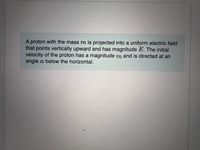Question
thumb_up100%
9. At what horizontal distance ‘d’ does the proton return to it’s original elevation? Express your answer in terms of ‘m’ ‘a’ ‘v0’ ‘E’ and electron charge ‘e’

Transcribed Image Text:A proton with the mass m is projected into a uniform electric field
that points vertically upward and has magnitude E. The initial
velocity of the proton has a magnitude vo and is directed at an
angle a below the horizontal.
Expert Solution
This question has been solved!
Explore an expertly crafted, step-by-step solution for a thorough understanding of key concepts.
This is a popular solution
Trending nowThis is a popular solution!
Step by stepSolved in 2 steps with 2 images

Knowledge Booster
Similar questions
- 23d) only typing Solve this question, without any mistakesarrow_forwardCh 18 q3 In 1910 Rutherford performed a classic experiment in which he directed a beam of alpha particles at a thin gold foil. He unexpectedly observed a few of the particles scattered almost directly backward. This result was not consistent with then current models of atomic structure and led Rutherford to propose the existence of a very dense concentration of positive charge at the center of an atom—the atomic nucleus. The alpha particle has a charge of +2e and the gold nucleus a charge of +79e. Suppose that an alpha particle is initially a great distance from the gold, has a kinetic energy of 4.20 MeV (4.20 106 eV), and is headed directly at a gold nucleus. How close will the particle come to the center of the nucleus? Treat the nucleus and the alpha particle as point charges.arrow_forward5. In below figure, a small, non-conductor ball of mass m =3.0 mg and charge q = 9.0 µC hangs from an insulating thread that makes an angle e charged non- conductor plane. Considering the gravitational force on the ball and assuming the plane extends far vertically and into and out of the page, calculate the area charge density of the plane. Length of string is 120.0 cm. 30° with a vertical, uniformly lo120cm + Jplonearrow_forward
- 5- chapter23-question13 Figures show four situations in which +ą -39 +3q charged particles are fixed in place on an axis. In which situations is there a point to the left (a) (b) +3q -9 <-34 +q of the particles where an electron will be in equilibrium? (c) (d) Option1 Option2 Option3 Option4 Option5 a and d b and c None a and b cand d Option3 b) tion1 c) Option5 d) Option4 e) Option2 Leave blankarrow_forward3) Four negative point charges of charge −Q are positioned as shown in the figure, each adistance a from the origin. a) Calculate the magnitude and direction of theelectric field at the origin. Then, with the charge on the right now removed, calculate the magnitude and direction of the electricfield at the origin for this three-charge configuration. b) The charge on the top is now removed aswell. Calculate the magnitude and direction of theelectric field at the origin for this two-chargeconfiguration. c) Calculate the magnitude and direction of theelectric force exerted by the two remaining chargeson a negative point charge of charge −q placed at theorigin. [Note that physics is case sensitive, so q isnot the same as Q.]arrow_forward5.) Protons can be approximated as spheres with a radius of about 8.5 x 10-16 m. Using Coulomb's law (which we saw at the beginning of the year), calculate the force required for two particles with the charge of one proton to be this far apart. While not exact, this gives a sense for how much force must be applied for the first step of this process to occur. Note: you will have to look up a couple of values here .. units are important, so it's probably best to work in Sl units.arrow_forward
- You run a comb through your hair and it becomes positively charged. Does its nass slightly increase or slightly decrease? Why? Where does the mass go to/come from?arrow_forward7 How can you tell which charges are positive and which are negative by examining the field lines? The arrows around a positive charge point away from the charge; the arrows around a negative charge point toward the charge The arrows around a positive and negative charge point away from the charges. The arrows around a positive charge point away from the charge; the arrows around a negative charge point toward the charge. The arrows around a positive and negative charge point towards the charges.arrow_forward
arrow_back_ios
arrow_forward_ios